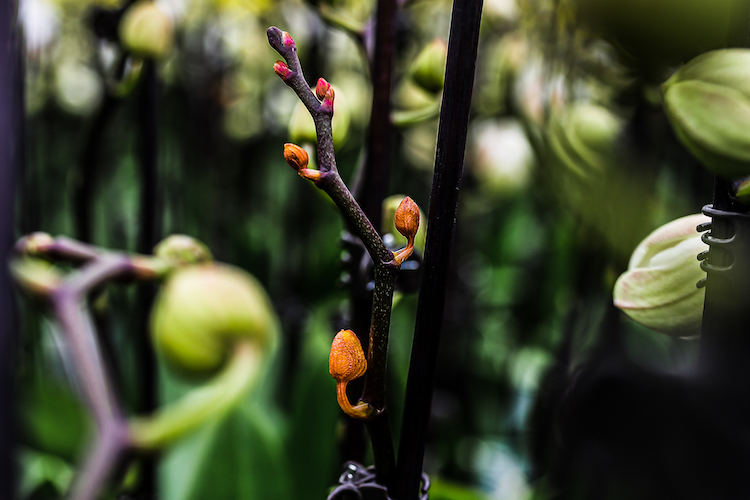
One of the joys of owning a Just Add Ice Orchid is the long blooming period. Phalaenopsis orchids are a particularly hardy member of the orchid family, and with proper care often bloom for as long as three months! But as with all living plants, Phalaenopsis orchids are susceptible to certain environmental factors that can cause the orchid plant to lose its buds, sometimes within days of arriving at your home.
If your orchid is prematurely dropping its buds before they bloom, or the flower buds begin to soften or become dry and brittle, you're dealing with bud blast. (Similar softening or drying can also occur to open orchid blooms, causing them to drop prematurely. When open blooms are affected, the condition is called bloom blast.)
Bloom and bud blast are generally caused by a sudden change in the orchid’s environment that traumatizes the plant’s systems. Dropping its buds or flowers signals the orchid’s reaction to environmental shock and is the plant’s way of protecting itself. By shedding its buds, the orchid can divert more energy to maintain its vital systems.
Understanding Orchid Bud Blast
Knowing the common causes of bud blast can help you protect your Just Add Ice Orchid and keep it healthy.
Exposure to drafts and other sudden temperature changes are the primary causes of bud blast. Because orchids obtain much of their moisture from the air, changes in humidity can also trigger bud loss.
Try to mimic their natural environment as much as possible — Phalaenopsis orchids grow on trees, which means they will not do well in potting soil. A potting mix made primarily of bark will work better.
The ethylene gas emitted by ripening fruit (including oranges, apples, bananas, etc.) can cause bud blast in orchids that are displayed in the same area. If you keep a fruit bowl on your kitchen counter or table, do not keep your orchid nearby.
Pests and diseases can also weaken the plant, making it more susceptible to bud blast. Fertilizer imbalances or excessive fertilization are additional contributors, as orchids are sensitive to nutrient levels.
Identifying what causes orchid buds to lose their buds allows you to take proactive measures—adjusting environmental conditions, modifying watering schedules, or addressing pest issues. Early intervention not only saves existing buds but also promotes overall plant vitality, encouraging future blooms.
Environmental Factors Impacting Bud Retention
Orchids are sensitive plants requiring specific environmental conditions for optimal growth. Temperature stability is critical to the longevity of your plant and its blooms; orchids prefer a consistent range between 65°F to 75°F (18°C to 24°C) during the day and slightly cooler at night. Sudden temperature shifts stress the plant, leading to orchid buds drying up and falling off. Maintaining a stable environment enhances orchid health and bud retention.
Humidity is another vital aspect of orchid health. Most orchids thrive in humid environments, ideally between 40% to 70% humidity. Low humidity can cause dehydration, stress the plant, and lead to orchid buds turning yellow and falling off. To maintain optimal humidity, use a humidifier or place a tray of water near your orchids. Regularly misting leaves helps sustain appropriate humidity levels.
Light exposure significantly impacts bud development. Orchids need bright, indirect light for optimal growth. Insufficient light hinders photosynthesis, weakening the plant and increasing susceptibility to bud loss. Conversely, excessive direct sunlight can scorch leaves and cause stress. Achieving the right balance of light exposure is crucial for healthy buds. Consider specialized orchid lighting to ensure your plants receive ideal light conditions.
Watering Practices and Their Effects
Watering is a crucial aspect of orchid care; improper practices can result in the loss of buds. Overwatering often manifests as yellowing leaves, which may feel soft or mushy. Underwatering can lead to wrinkled, limp leaves, resulting in orchid buds drying up and falling off as the plant conserves moisture. Recognizing these signs helps adjust your watering routine effectively.
To establish an effective watering schedule, consider your orchid species' specific needs. While most orchids thrive with weekly watering, this frequency can vary based on environmental conditions such as humidity and temperature. A good rule of thumb is to allow the potting medium to dry slightly between waterings. A moisture meter provides insights into when your orchid needs water.
Potting medium and drainage are crucial. Orchids require a well-draining mix, such as bark or sphagnum moss, to prevent water retention around roots, which can lead to rot and cause orchid buds to turn yellow. Ensure your pot has adequate drainage holes for excess water escape. Combining proper watering practices with the right potting medium creates an optimal environment supporting healthy blooms and reducing the risk of orchid buds falling off.

Copyright Just Add Ice® Orchids 2023